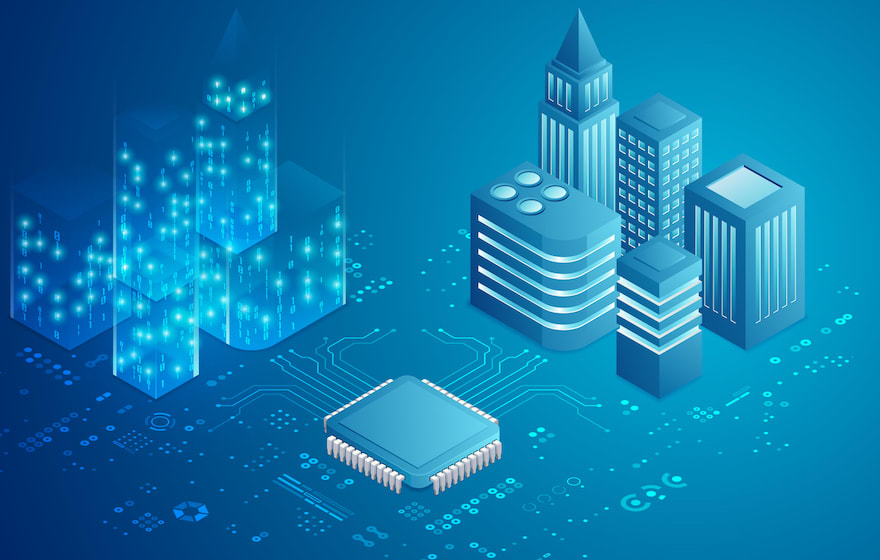
The only way to create a national digital twin is to establish the common frameworks, standards and interfaces to enable component digital twins to be crowd-sourced, and then connected. Paul Clarke, Ocado
Paul Clarke is chief technology officer at Ocado. From his involvement in the online grocer’s near-20-year journey to digital twinning, he offers his conclusions on the simulation and emulation techniques that were required to design, build and operate its highly sophisticated and heavily automated warehouses.
Ocado is a great example of how some of the most exciting applications of artificial intelligence (AI) and machine learning (ML) and robotics lie where these digital and physical worlds collide. Digital twins are the third member of this disruptive family of technologies, and the Internet of Things is another one.
Digital twins enable you to explore the physical world faster, cheaper and with less risk. Digital twins enable ML models to explore and optimise digital worlds to find solutions that are beyond human scale.
Digital twins enable you to stress test your systems by subjecting them to potential perturbations and exceptions. For example, a digital twin of a city that included models of the emergency services and hospitals might allow you to explore the impact of a plane crash or a terrorist attack.
After an accident on a motorway, it’s common for waves of congestion to still persist even when the accident has been dealt with. This is why rather than just reopening the motorway and allowing cars to simply drive off at full speed, the police will often drive in front of the cars and slowly accelerate in order to prevent standing waves of congestion from being established. Similarly, digital twins can help us find ways to return a perturbed system back to its steady state
Digital twins can help us answer “what if” questions about the future such as the potential impact of climate change, disruptive changes to systems such as the impact of local energy generation and electric vehicles on the national grid, the impact of new policies or regulatory frameworks and so on.
You can explore a lot using simulations, but eventually you need to start experimenting in the real world. This is where living labs come in. They provide a physical environment that is representative of the real world, but initially more constrained. You can then loosen those constraints over time as your capabilities and confidence grows. Living labs are not technology demonstrators, they are about “learning by doing”, using experiments to deliver real services to real customers – both commercial and consumer.
Why? Because customers keep you honest, they give you feedback, they help drive innovation, pace and agility. Digital twins continue to provide value as part of a living lab, allowing you to evaluate new ideas before you try them in the lab.
Along with our consortium partners, we are working to establish a living lab in Hertfordshire to explore the intersection of autonomous vehicles, drones, robots, smart infrastructure and smart services. The first thing we will do is of course to build a simulation of the living lab, which will evolve into a digital twin.

National digital twin
Thinking about digital twins at a national scale leads to the vision of creating a national digital twin (NDT) of the UK. This is a truly ambitious vision that some might dismiss as unachievable, but then most people would have dismissed Google Street View as unachievable until it was done.
No one company can build the NDT and indeed no one company should own it – it can become a new piece of national infrastructure. The only way to create an NDT is to establish the common frameworks, standards and interfaces to enable the thousands of component digital twins to be crowd-sourced, and then connected together via data marts. These need to be open sourced or owned by national government.
The component digital twins will inevitably be built using different technologies and at different levels of fidelity and abstraction. They will need to be joined up horizontally such as transportation, smart cities and energy. They will also need to be joined up vertically such the digital twins of individual drones, an automated air traffic control system and the wider air transportation system. There is research that needs to be undertaken on the science of digital twins such as how best to couple them given different levels of abstraction, fidelity and latency.
One of the challenges facing the creation of data marts and data trusts is how to manage the data that won’t be open and free of charge. How to handle the fact that companies might be willing to share datasets for the greater good but not to have them weaponised by their competitors. This all leads to the concept of data passports to control whom the data can be shared with and for what purposes.
The same challenge will go for digital twins when we start to share and conjoin them.
There will be significant security considerations associated with creating an NDT, especially if and when the underlying digital twins are coupled to the respective control systems for their physical twins. This will effectively be creating a country-scale operating system.
Building an NDT is a task that will never be completed – there will always be more elements and higher levels of fidelity to model. The good news is that each component digital twin will deliver value in its own right, and the interconnection of these digital twins will deliver additional value above and beyond the sum of the value of the component digital twins.
For example, having a digital twin of the UK rail network will deliver benefits such as optimising timetables, minimising delays, de-risking the impact of maintenance activities and so on. However, when combined with digital twins of the bus, freight and road networks, along with airports and seaports, it will deliver insights and optimisations across the transportation network as a whole. Then you might add a digital twin of the energy network to optimise the power distribution required to support the electrification of transport and so on.
We are collaborating with Centre for Digital Built Britain (CDBB) and others on this vision for an NDT. This includes digital twins for the built environment such as those mentioned above. It also needs to include digital twins for institutions such as the NHS, national government, our financial system and so on. Then we will want digital twins of aspects of the natural environment such as weather, agriculture, flood prevention and so on.
An NDT could enable us to make better use of scarce resources such as time, energy and land while minimising the unintended consequences such as waste and pollution. Indeed, one of the most important applications of an NDT would be to help us achieve the UN Sustainable Development Goals.
If you enjoyed this and want to read more, you can find Paul Clarke’s blog post in full here: https://www.cambridge.org/core/blog/2020/06/23/data-centric-engineering-where-physical-and-digital-worlds-collide/
The Data-Centric Engineering journal is an open access journal from Cambridge University Press exploring the potential of data science for all areas of engineering science and practice; find it here: https://www.cambridge.org/core/journals/data-centric-engineering
Image: 159665796 © Jakarin Niamklang | Dreamstime.com















